#MakeItBetterMonday – Keep Your Powder Dry
Black powder and the American Revolution
The Revolutionary War was fought on both sides of the battle lines by armies equipped with smooth bore, muzzle loading flintlock muskets. Cartridges rolled out of paper and filled with a musket ball and black powder were individually loaded and down the muzzle of the musket, packed at the breach with a ram-rod and fired by igniting a small amount of black powder in the priming pan. A good soldier could load and fire his weapon three or four times per minute.
None of this worked very well if the black powder got wet, so it was important to keep your powder dry! Prepared cartridges were carried in a leather cartridge box and loose black powder was often carried in a hollow horn of an ox or cow, fitted with a cover and a strap to carry it.
George Washington’s Continental Army had a lot of trouble getting enough black powder to keep the soldiers and artillery properly supplied. Almost all the black powder used during the American Revolution had to be imported from France or the French West Indies. One of the only working black powder mills in America was the Frankford Powder Mill, in what is now part of Philadelphia!
Black powder is a mixture of three ingredients. This means that each ingredient remains distinct within the formula. They were ground together in mills, much like a grain mill. Powder mills were powered by wind or water and located away from heavily populated areas because of the risk of accidental explosion.
You can keep your powder dry in a powder horn that you create out of simple materials you probably have at home!
- 12-inch square of poster board or similar material – I used an old gift box that I cut to size!
- Tape
- Scissors
- 6 pages of newspaper
- ½ cup of flour
- 1 cup water
- Bowl
- Whisk
- Craft paint and paintbrush
- Marker
- 36 to 48 inches of string, yarn or ribbon
This is a fun but messy project, so cover your work surface with an old tablecloth, extra newspaper or a garbage bag.
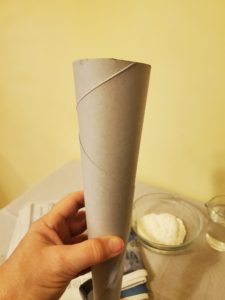 Roll the poster board into a cone shape and tape it to hold together – a staple at the wide end is helpful. Trim the wide end so that it is flat and even.
Roll the poster board into a cone shape and tape it to hold together – a staple at the wide end is helpful. Trim the wide end so that it is flat and even.
Tear the newspaper into strips about 2 inches wide.
Mix the flour and water in the bowl.
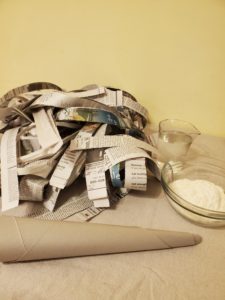 Wet several strips of newspaper at a time in the flour mixture. Take one strip at a time out, wipe off the excess liquid and apply it to the cone. As you build layers, try and smooth them out. Add strips to the narrow end and twist them up to make the curved point.
Wet several strips of newspaper at a time in the flour mixture. Take one strip at a time out, wipe off the excess liquid and apply it to the cone. As you build layers, try and smooth them out. Add strips to the narrow end and twist them up to make the curved point.
When you are pleased with the shape, set it aside on a plastic bag to dry overnight. Don’t forget to clean up your mess!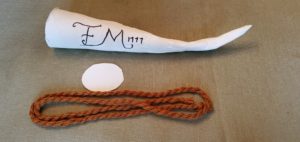
The next day, trace the open end on a scrap of poster board and cut this out to make the lid.
Paint everything! Horns were naturally an off-white to light tan color but you can decide what color you want based on what color paint you have at home. When the paint is dry you can decorate it with the marker.
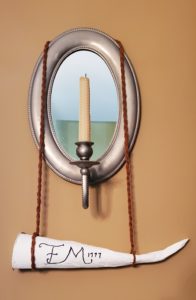 Soldiers often carved things in their powder horns during long winter days in camp. They might carve their initials or name, battles they fought in, or popular expressions. How will you decorate yours?
Soldiers often carved things in their powder horns during long winter days in camp. They might carve their initials or name, battles they fought in, or popular expressions. How will you decorate yours?
Attach the lid with a piece of tape or string attached through a hole in the top of the horn. Then attach your carrying string and you are ready to join General Washington!
Learn more!
Read about the gunpowder supply in the American Revolution
Discover the powder horn that belonged to an African American patriot.
And watch this video from the American Battlefield Trust.

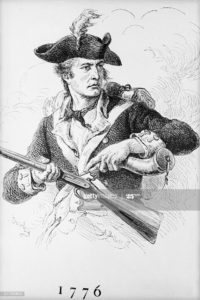
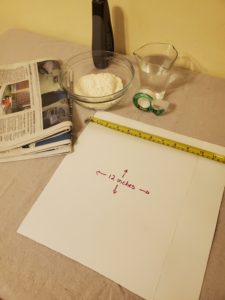
Philadelphia Magazine's Best in Philly© 2018 - Best Overlooked Tourist Attraction!